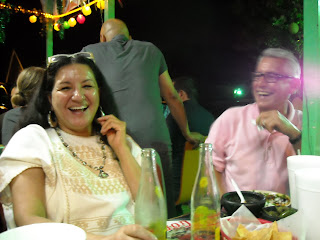 |
| Sandra Cisneros, Macondo Writing Workshop 2007. San Antonio, Texas. |
As a quick context for the story, check out the newspaper story below.
Author traces the many paths of her father's story /
Sandra Cisneros' "Caramelo" a nine-year project
By then, Sandra Cisneros knew that her tale of a rollicking family road trip from Chicago to Acapulco was more than a raconteur's yarn.
"I knew it was my father's story," she says. "But it kept getting bigger and bigger. I realized it wasn't a short story, and I saved it for a novel."
That novel, "Caramelo" -- an energetic, multigenerational epic-- took her nine years to write and has just been published by Knopf. During those nine years, Cisneros' life took extreme turns: She lost her father to cancer and was awarded a MacArthur Fellowship.
The book starts with that road trip and branches out once the family pulls up to the green iron gates of the ancestral home in Mexico City, the house itself teeming with stories. Written from the point of view of a young Chicana named Lala whose father resembles Cisneros' own (" 'I was the favorite child of a favorite child,' " says Lala), its episodic chapters jump through time, with historical asides and whimsical footnotes.
Born in Chicago in 1954, Cisneros is the only daughter of a Mexican father and Mexican American mother. Her father came from a middle-class family in Mexico City. His old-country elegance served him well in the States, though his business wasn't always stable. The family moved from one fixer-upper flat in Chicago's "Pilsner barrio" to another, and spent summers in Mexico City with relatives.
Privacy was hard to come by for a young girl with six brothers, so reading and writing became Cisneros' escape. But it wasn't until she was a graduate student at the University of Iowa Writers' Workshop that she found her subject -- and her voice.
Her career took off with the 1984 publication of her first book of stories, "The House on Mango Street." Cisneros called it "anti-academic." Critics called it "a literary masterpiece" and dubbed Cisneros "the representative Chicana in the reconstruction of the canon." When her second collection came out, the New York Times called her "an educator, unerring and relentless . . . not only a gifted writer but an absolutely essential one."
It's a mantle she carries with grace. Committed to community work, she continues to give readings and workshops in her hometown of San Antonio and beyond.
In her teaching, as well as in her poetry and essays, she engages the question of fiction and autobiography -- a prickly topic at best.
In "Caramelo," Cisneros was driven to connect the dots. "The people are based on real people, but I invent things because I don't know what really happened." Family stories are lovingly gathered -- she calls them "bits of string" -- and pieced into a new puzzle, one she can resolve. A disclaimer at the front of the book announces: "If, in the course of my inventing, I have inadvertently stumbled on the truth, perdonenme."
Though the book was inspired by a real journey, she says, "I kept getting sidetracked."
Believing that "detours are destiny," she explored every one, plumbing the histories of the people in her father's life -- his brothers, his parents, his grandparents, the aunts, the uncles. In one end-of-chapter aside, she writes: ". . . a life contains a multitude of stories and not a single strand explains precisely the who of who one is."
"My book is very Buddhist in its concept," she says. "I'm a Buddhist now, so I tried to look deeply at how my father became who he is." (Cisneros became a Buddhist while teaching for a semester at UC Berkeley, when a friend gave her a copy of "Being Peace" by Thich Nhat Hanh.)
Winning the MacArthur Foundation Fellowship in 1995 helped her look deeply. "The grant allowed me five extra years to work on the novel to make the book take off."
More important? "I was able to take a year off to vigil my father -- to stop everything for a year -- when he was dying of cancer. That was a great, lasting gift."
Writing the novel "was like painting the Sistine Chapel when you're used to painting miniatures," she says. "What came before were all small projects. This was a big book."
The big book has an additional purpose: It is her response to the xenophobia and violence she sees in American culture. With that in mind, she recently sent a copy to Laura Bush, suggesting that she read it to the president.
"Maybe this is my own peace protest," says Cisneros. "I thought Bush needed to look at borders and immigrants -- to help to mend the relationship between the U.S. and Mexico, but also to look at America's relationship with immigrants, since global immigration is our future."


No comments:
Post a Comment